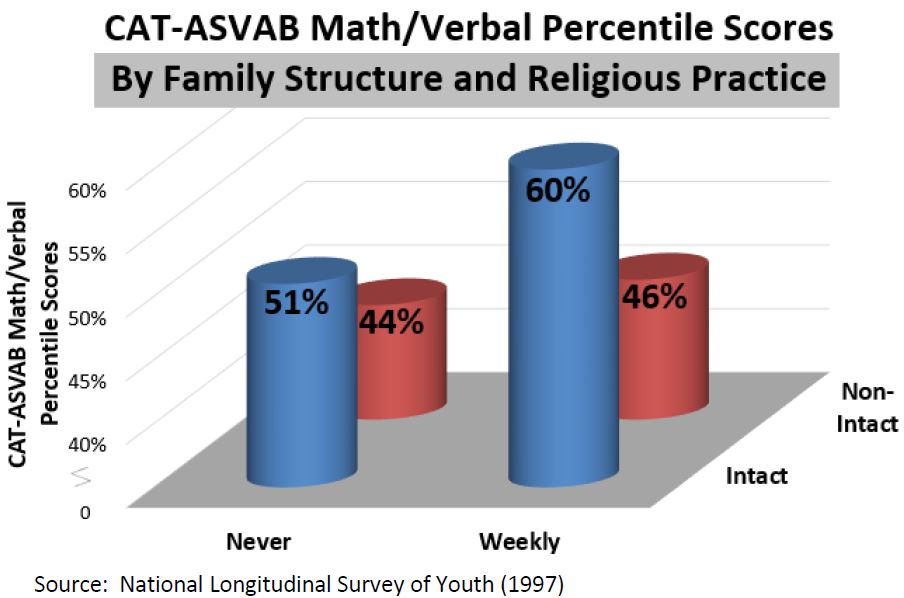Click Here to download “CAT-ASVAB Math/Verbal Scores by Family Structure and Religious Practice”
CAT-ASVAB Math/Verbal Scores by Family Structure and Religious Practice
The 1997 National Longitudinal Survey of Youth shows that those who grew up in an intact married family and who worshipped at least weekly at the time of the survey had higher CAT-ASVAB (Armed Services Vocational Aptitude Battery computer adaptive test) math and verbal scores. [1] Family Structure: Children from married, always-intact families scored in the 58th percentile, followed by children from married stepfamilies and divorced single-parent families (48th percentile). Children from intact cohabiting families scored in the 42nd percentile, children from cohabiting stepfamilies scored in the 35th percentile, and children from always-single parent families scored in the 28th percentile. Religious Practice: Children who attended religious services at least weekly at the time of the survey scored in the 54th percentile, those who attended at least monthly scored in the 51st percentile, those who attended less than monthly scored in the 49th percentile, and those who never attended religious services scored in the 45th percentile.
Religious Practice: Children who attended religious services at least weekly at the time of the survey scored in the 54th percentile, those who attended at least monthly scored in the 51st percentile, those who attended less than monthly scored in the 49th percentile, and those who never attended religious services scored in the 45th percentile.
 Family Structure and Religious Practice Combined: Those from always-intact families who attended religious services at least weekly scored in the 60th percentile on the CAT-ASVAB. Children from always-intact families who never attended religious services scored in the 51st percentile. Among those from all other family structures, the difference is less pronounced: those from all other family structures who attended religious services at least weekly scored in the 46th percentile, and those from all other family structures who never attended scored in the 44th percentile.
Family Structure and Religious Practice Combined: Those from always-intact families who attended religious services at least weekly scored in the 60th percentile on the CAT-ASVAB. Children from always-intact families who never attended religious services scored in the 51st percentile. Among those from all other family structures, the difference is less pronounced: those from all other family structures who attended religious services at least weekly scored in the 46th percentile, and those from all other family structures who never attended scored in the 44th percentile.
 Related Insights from Other Studies: A study conducted by Grace Kao of the University of Chicago found that living in a single-mother family had a particularly detrimental effect on grades for Asian youth in the United States.[2] The results of a study of religiosity and the academic achievements of minority students by Professor William H. Jeynes of California State University, Long Beach, “indicate that very religious Black and Hispanic students outperformed less religious students in academic achievement.”[3]
[1] These charts draw on data collected by the National Longitudinal Survey of Youth (1997).
[2] Grace Kao, “Asian Americans as Model Minorities? A Look at Their Academic Performance,” American Journal of Education, Vol. 103, No. 2 (Feb. 1995): 148-149.
[3] William H. Jeynes, “The Effects of Religious Commitment on the Academic Achievement of Black and Hispanic Children,” Urban Education 34.4 (1999): 473.]]>
Related Insights from Other Studies: A study conducted by Grace Kao of the University of Chicago found that living in a single-mother family had a particularly detrimental effect on grades for Asian youth in the United States.[2] The results of a study of religiosity and the academic achievements of minority students by Professor William H. Jeynes of California State University, Long Beach, “indicate that very religious Black and Hispanic students outperformed less religious students in academic achievement.”[3]
[1] These charts draw on data collected by the National Longitudinal Survey of Youth (1997).
[2] Grace Kao, “Asian Americans as Model Minorities? A Look at Their Academic Performance,” American Journal of Education, Vol. 103, No. 2 (Feb. 1995): 148-149.
[3] William H. Jeynes, “The Effects of Religious Commitment on the Academic Achievement of Black and Hispanic Children,” Urban Education 34.4 (1999): 473.]]>
